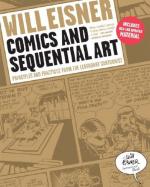
|
| Name: _________________________ | Period: ___________________ |
This test consists of 5 multiple choice questions, 5 short answer questions, and 10 short essay questions.
Multiple Choice Questions
1. What approach predominates because comics mix letters and images?
(a) The visual.
(b) The tactile.
(c) The sensory.
(d) The lingual.
2. What must artists know about the force of gravity?
(a) The movement of clothing doesn't respond to gravity.
(b) Everything on earth responds to gravity.
(c) Gravity doesn't work the same everytime.
(d) Gravity is a force to be reckoned with.
3. What is usually the key to a gesture's meaning?
(a) The final position.
(b) The final panel.
(c) The final bubble.
(d) The final sketch.
4. What is the most useful and most used word in comics?
(a) Meanwhile.
(b) Now.
(c) During.
(d) Consequently.
5. What is often predetermined by the nature of the story?
(a) Linear or algebraic style.
(b) Graphic or illustrative style.
(c) Humorous or realistic style.
(d) Surrealist or Dada style.
Short Answer Questions
1. In what person does Eisner illustrate and recast Hamlet?
2. What can artists be tempted to do to detract from the storyline?
3. When can artists render color directly over line work?
4. What was the name of Eisner's 1981 attempt to illustrate Shakespeare's famous soliloquy of Hamlet?
5. What kind of movements flow together over short periods?
Short Essay Questions
1. Why does Eisner reproduce several pages from his graphic novel To the Heart of the Storm along with a close-up pencil dummy page?
2. How are comic book artists most challenged in portraying amorphics?
3. Why are technical skills mandatory for comic book artists?
4. Give a brief synopsis of Chapter 7.
5. Give a brief synopsis of Chapter 8.
6. Why are the body's gestures and postures stored in the artist's memory as a non-verbal vocabulary?
7. Why do people make important daily judgments about faces?
8. Give a brief synopsis of Chapter 6.
9. Why should an artist read short stories?
10. What temptation do artists have to detract from the text?
|
This section contains 752 words (approx. 3 pages at 300 words per page) |

|




